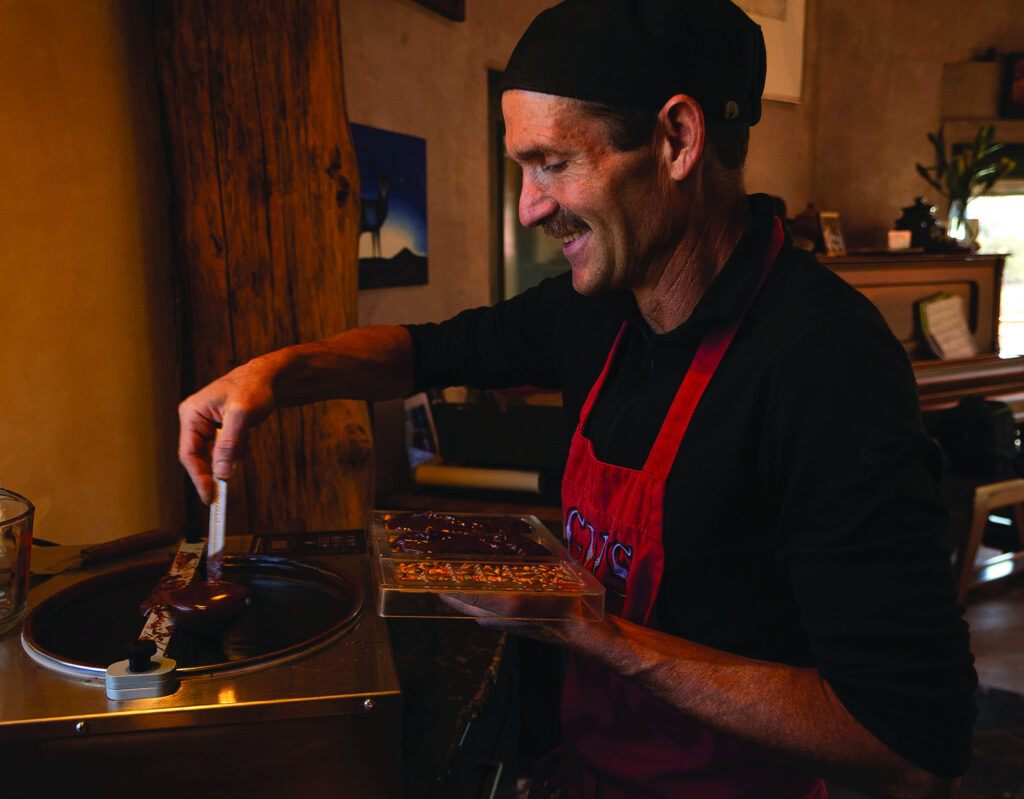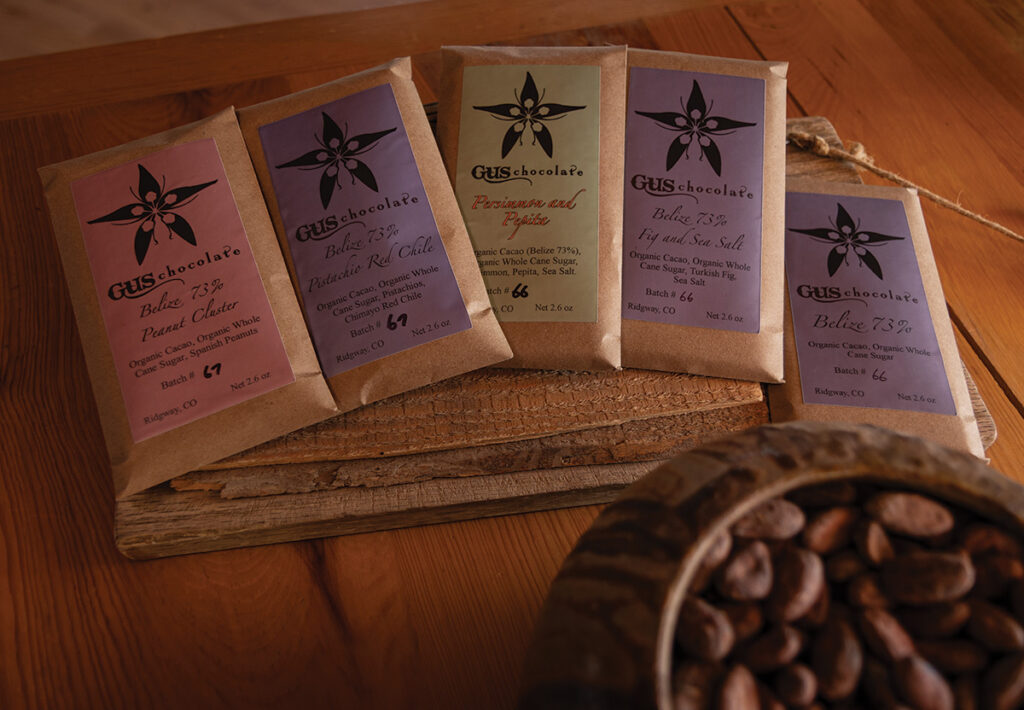Past a gate, at the end of a dirt road on Log Hill Mesa, is an Ouray County-style Willy Wonka factory.
From his off-grid home, Nathan Montgomery churns small batches of chocolate, entirely powered by a solar grid that mimics the shape of his chocolate bars.
Some people may recognize the local artisan chocolate maker from his seasonal sales at Ridgway’s Noel Night. But now that he’s finished building a home equipped for crafting his chocolate, Montgomery is focusing on his business, Gus Chocolate, full-time.
Gus Chocolates owner Nathan Montgomery stands in front of his new, off-grid Log Hill home and solar panels that power his chocolate-making operation. He recently launched the business full-time. Erin McIntyre – Ouray County Plaindealer
Inside a home chocolate studio
On a Friday morning, he checks the temperature of a revolving pool of rich dark liquid.
He closes all the windows and doors to get the temperature just right. Half a degree can make all the difference.
After it reaches the right temperature, he quickly starts ladling scoops of the shiny, warm chocolate onto trays filled with dried bits of persimmon and pumpkin seeds, banging the molds against the countertop to rid the bars of any air bubbles.

Small-batch chocolate making involves everything from fermenting and roasting the cacao beans to grinding them and melting the chocolate to a perfect temperature for pouring into bars. Gus Chocolates owner Nathan Montgomery learned the art 15 years ago but just recently made his business a full-time gig. Erin McIntyre – Ouray County Plaindealer
Within 10 minutes, Montgomery has more than 20 new chocolate bars cooling in the basement he built specifically for crafting chocolate, as the space stays cool through the summer. Montgomery has made chocolate in Ouray County out of various rental home kitchens since 2010, though he’s purposefully kept a low profile and built his customer base largely by word-of-mouth.
Naming his business after his childhood nickname, Gus, added to the mystery of it all.
Montgomery has laid low primarily to retain the quality of his product and better enjoy the process.
“It was more of a lifestyle choice over, you know, over a scaling, kind of capitalist success choice,” Montgomery said.
But with a new home that doubles as a chocolate studio, he’s able to increase production and run the business as a full-time gig. He used to work in the kitchen at Colorado Boy, where some of his customers would come to buy chocolate.
He’s considered working out of a commercial kitchen but enjoys the smaller process and community of customers that come with having a cottage food industry license.
“I like the idea behind it, because it’s direct. I have to have a direct relationship with my customers,” he said.
Products created with cottage industry licenses must be sold directly to consumers rather than to other retailers. He doesn’t see the requirement as a bad thing or a limitation.
“It connects me to people, and I feel like it’s more of almost not a gift exchange, but it’s more of a trade economy,” Montgomery said.
He sells his chocolate bars for $10 apiece but sometimes gifts them to friends and loyal customers. As his operation grows, he’s eager to meet more customers and share his sweets.
Learning to make chocolate from cacao bean to bar
Montgomery learned the art of chocolate-making 15 years ago after a friend purchased land in Ecuador covered in cacao trees.
His friend hired pastry chef Nathan Miller to help create a chocolate company, and Miller brought on Montgomery as an apprentice.
The two refined their skills together, while Miller climbed the ranks of chocolate recognition, even ranking No. 5 in a blind taste test of bean-to-bar chocolate samples by The New York Times.
Montgomery decided to start his own bean-to-bar chocolate business after moving to Ouray in 2010. The first place he sold his product was at the Ouray Wine, Chocolate and Cheese festival.
Montgomery loves the history and art of chocolate, down to the cacao beans, where he believes the greatness begins.
How cacao beans are sourced and treated is what distinguishes good chocolate from great chocolate, Montgomery said.
“Really great chocolate it’s 1/3 the actual cacao, it’s 1/3 the fermenting, and it’s 1/3 the roasting. That’s what distinguishes really great chocolate, is somebody who’s actually paying attention to the cacao beans,” he said.
“It’s such a mysterious food,” Montgomery said.
He described how cacao beans were used as currency in ancient Mesoamerica, when they were crushed into a liquid for drinking — Montgomery’s preferred way to consume chocolate.
Chocolate candy bars were the result of the industrial revolution, when large companies like Hershey’s and Cadbury created machinery able to produce them.
Artisan chocolate makers didn’t begin breaking into the industry until about 40 years ago, when they started building and creating their own equipment.
Chocolate makers are people like Montgomery, who make chocolate from whole beans to bars, rather than chocolatiers who buy premade chocolate to make truffles or other types of candy.
Montgomery created his own cacao bean grinder from a reworked piece of equipment from an Indian restaurant, where it was used to crush wet legumes into paste.
He sources his cacao beans from Belize and has a specific tactic and temperature for roasting the beans that brings out complex flavors, and at a particular temperature, makes your eyes water.
Montgomery has been refining his chocolate process for years, though the ingredients remain simple: cacao beans and sugar. His plain dark chocolate bar uses 73% cacao. He also makes bars with added flavors. One of his bestsellers has New Mexico red chiles and pistachios.
He’s proud to say a Swiss customer buys dozens of those bars each year.

For weeks, Montgomery has been ramping up his production ahead of Noel Night this year, where he makes much of his annual sales and plans to sell his chocolate bars again.
Those interested in visiting Montgomery can find him at the event or contact him for more information at guschocolate.com.

